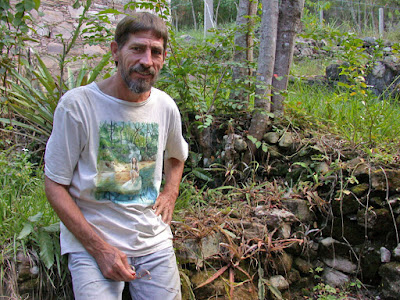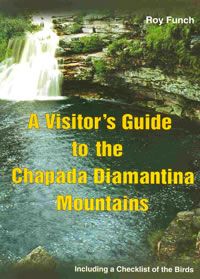Gilberto is
an old-time diamond miner (garimpeiro),
as was his father and grandfather, going back in time (almost certainly) to the
slaves who were brought in to work the mines (Brazil only fully abolished
slavery in 1888).
I've known Gilberto
for years, and he can usually be found at a friend’s house at the foot of the
hills. He spent most of his life living in a crude rock shelter in the
mountains near his diamond claim, and feels much more at home away from the
"big city" of Lençóis (population 10,000).
I had arranged
for Gilberto to take me up into the mountains today to visit the
"Bananeira" (banana tree), a small settlement of diamond miners in
the old days, but now totally abandoned. To start the day (8:00 AM) he put down
half a glass of "cachaça"
(local rum) in one swallow, and off we went
The trail
followed a popular tourist route for about a mile and then branched off to the
south. I'm usually pretty good at following the old trails in the mountains,
but this was exclusively over an exposed rock surface that had been little-used
for years, so it all depended on Gilberto's sense of direction from his
hundreds of trips in.
We came
across an old shelter ("toca")
at the "Bananeira" site that had been built under a wide sandstone
ledge, and closed off with mud-and-wattle walls. These sites have been serially
occupied over the decades (and centuries) by different generations of miners –
and the last "owner" had been "remodeling" it by erecting stone
walls (no mortar) to replace the mud walls when he died (of old-age) – so the
job will remain incomplete. Nearby was a set of three tocas all in a row under an especially long rock overhang, each
maybe 4 m wide and 3 m deep. One of them had been Gilberto’s father’s, and then
his, but all three were totally abandoned now and in various states of
disrepair. Tin cans, lots of cut wood (saplings) used to fashion crude beds,
and a few old, rusting tools and assorted pieces of litter were strewn about.
There was another very long and narrow toca
near the creek. Floodwaters had washed away the outer wall, and but Gilberto
told me that when he was younger there had been a good number of miners living
there, while others slept under available rock overhangs wherever they could
find them.
I took some
documentary photographs and GPS readings then hiked down the Bananeira Creek to
the Bananeira Falls (not too much water that day, but must be spectacular when
it rains – with a sheer 20 m drop). We then turned upstream to find the toca where “Mãe-da-Lua" used to
live (the nickname translates to "mother of the moon"). She was a
diamond miner and apparently quite a character, sober at the diggings, but usually
drunk and wild in town. This was about 40 years ago.
We were
walking in the stony bed of the Bananeira Creek when Gilberto mentioned that
there was a "homestead" on each side of the watercourse. Only someone
who had lived there could have identified those sites, as they were both now
completely overgrown and hidden by the heavy vegetation. I crashed my way
through the entangled plants and the vestiges of loose mining debris to find
small meadows completely overgrown by
Brazilian stinkgrass (Melinis
minutiflora, and African invasive species) – a sure sign of past human habitation.
The grass was chest high and daunting to wade through, as it was impossible to see
where you were stepping. I eventually arrived at (in both cases) the ruins of a
very small, old stone house. Each seemed to be a simple one-room structure
(about 3x4 m), with the end-walls peaking to about 2.5 meters to hold the roof
beam. The sidewalls were made of stone and were only about 1 m tall – almost
certainly having been completed to the roof with mud-and-wattle walls. The
doorframe (opening) was on one of the walls that supported the roof (photo).
The old
houses got Gilberto talking about the farming plots that the miners planted while
working their claims. Miners were, of course, focused on mining – but they
still had to eat. The mountains weren't really appropriate for farming or
cattle raising, so the miners (and the towns that sprung up in the hills) were
largely dependent on the corn, beans, and dried meat brought in by mule from
settlements in the flatland "caatinga" and "cerrado" areas to
the west (and to a certain degree, to the east) of the mountains. Cattle were driven
in along traditional trails, which can still be seen in places between the
towns of Palmeiras and Guiné.
As the
population of the mining zone increased and became more established,
agricultural valleys such as Capão and Pati (and smaller sites such as Capão do
Correio and Baixa Funda) were occupied by families that divided their efforts
between agriculture and mining, becoming exporters of coffee, bananas, oranges,
beans, manioc and manioc flour, chickens and eggs, etc., to the mining communities
around them on less amenable sites.
The miners
in the mountains usually tended small gardens and kept chickens (there was even a stone chicken coop at the Bananeira site, a kind of miniature shelter right next to the other ones, only with a lower ceiling).
As we walked
back to Lençóis, Gilberto told me that all of the wooded areas on the hilltops (which
the miners couldn't reach with their stream diversions/primitive aqueducts and erosive
mining – so they still had soil covers) had all been cleared and planted when
he was young. Every available plot of land that still had soil on it, all along
the trail back to town, had been farmed in the old days –mostly with manioc,
"andu" beans, rustic
pineapples, sugarcane, corn, and fruit trees (oranges, mango, jackfruit). This
helps explain the fact that you almost never see old-growth forests anywhere
except deep in the hills and far from the diamond region. Between cutting wood
for construction/cooking and clearing for planting, all the forest sites (with
very few exceptions) were cleared at one time or another. They are now covered
with secondary growth vegetation– small trees (less than 15 cm [6 inches] in
diameter), very closely spaced, with dense understories and low biodiversity.
The natural native
vegetation is now slowly returning to the forest/farming plots that had been
cleared and to the mountainsides that had been stripped of both plants and
soils –like a Brazilian episode of the television series "Life after
People" – as nature takes charge again.
I never did
get to see the toca where
“Mãe-da-Lua" used to live. We passed it, but Gilberto either forgot to
show me the spot or, more likely, he was really in a hurry to get back to
"civilization" and have another drink, and passed it by. Next trip.







